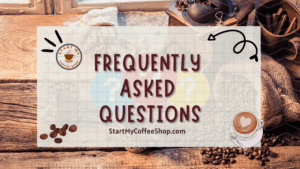The process of preparing coffee can be viewed as the start of a multi-sensory trip. Whether you consider yourself a coffee expert or simply like the beverage on occasion, knowing how to create a cup of coffee that is both tasty and appealing is a useful skill to have.
To make coffee, you should boil water, grind fresh coffee beans, or if you already have it, put 1-2 tablespoons of ground coffee in a cup. Let it steep for a few minutes, stir, wait for the grounds to settle, and add milk/sugar to taste, if desired.
In this article, we will examine the steps required to brew flavorful and aromatic coffee. By adhering to these simple techniques, you will always be able to experience a perfect cup of coffee.
Boiling Water and Grinding Fresh Coffee Beans

The carefully considered consideration given to the quality of its ingredients forms the basis of an excellent cup of coffee. The temperature of the water and the size of the coffee beans’ grind are two important variables in producing a tasty and harmonious brew.
- Start with fresh, filtered water to get things going. You cannot stress the value of using fresh water. Coffee can taste bad if the water has been hanging around too long or contains contaminants. By utilizing filtered water, you can guarantee a clear brewing surface by eliminating any potential off flavors.
- The temperature of the water then plays a crucial role in the brewing process. The ideal temperature range for the water is 90-96°C (195-205°F). The ideal flavor extraction from the coffee grounds can take place within this temperature range without burning the grounds. The use of boiling water directly on coffee grounds should be avoided as this can cause over-extraction and a bitter taste. The perfect atmosphere for extracting the complex flavors from the coffee beans is created by carefully monitoring and regulating the water temperature.
- It’s time to concentrate on grinding the fresh coffee beans while the water is heating. The primary factor that affects the rate of extraction is the grind size. The majority of brewing techniques call for medium grind size. This consistency creates a cup of coffee that is properly extracted by striking a balance between surface area and extraction time. For well-liked brewing techniques including pour-over, drip brewing, and French press, a medium grind size is ideal.
- It’s crucial to take your chosen brewing technique into account while grinding the coffee beans. To maximize the extraction process, various brewing techniques call for particular grind sizes. For instance, whereas espresso calls for a finer grind, pour-over, and drip brewing methods often demand a medium grind. You can get the flavor profile you want by knowing the proper grind size for the brewing method you’ve chosen.
You can create a great cup of coffee by using medium-finely ground coffee beans and fresh, filtered water that has been heated to the proper temperature. These important procedures, together with other elements like the coffee-to-water ratio and brewing time, affect the final brew’s flavor and aroma overall. The focus on these particulars reveals the commitment and enthusiasm for creating a great coffee experience.
Read more about: Small Coffee Shop Start-up Costs: Building The Blocks
Brewing Techniques
Now that you have hot water and freshly ground coffee, let’s examine various brewing methods to find one that suits your tastes.
- Pour-Over Method: Coffee lovers who value accuracy and control over the brewing process frequently choose for the pour-over method. Start by inserting a filter into a pour-over dripper or coffee cone to make coffee using this method. The filter should be filled with the necessary volume of medium-ground coffee.
Next, slowly pour hot water that is just below boiling point in a circular motion over the coffee grinds. By using this method, the water may completely saturate the coffee grounds and draw out the flavors as it moves through them. After that, the coffee drips into a carafe or cup that is positioned underneath the dripper.
An advantage of the pour-over process is that it yields coffee that is clear and well-balanced. To create your ideal flavor profile, you can vary factors like water temperature, pouring rate, and brewing duration. You can experiment with various coffee-to-water ratios and pouring methods as you gain experience to further hone your pour-over brewing abilities.
- French Press: Commonly referred to as a plunger or press pot, is a time-honored and simple way to brew coffee. To separate the brewed coffee from the grounds, it is necessary to steep coarsely ground coffee in hot water for a short period.
Start by placing the necessary quantity of coarsely ground coffee in the bottom of the press before beginning to brew coffee. Make sure the coffee grinds are completely covered by hot, just-off-the-boil water before pouring it over them. To allow the flavors to meld, let the coffee steep for about four minutes.
After the steeping period, slowly depress the plunger to force the grounds toward the bottom where they will be caught by the filter. By separating the brewed coffee throughout this process, a robust and full-bodied cup is produced.
The French press method is highly regarded for its capacity to retain the coffee’s natural oils and tastes, producing a rich and aromatic drink. It provides a robust and full-bodied coffee experience that lets you fully enjoy the variety of tastes. You may adjust the strength and intensity of your French press coffee to your preferences by experimenting with various coffee-to-water ratios and steeping times.
- Espresso Machine: An espresso machine is the best option if you are looking for a concentrated and intense coffee experience. With this technique, hot water is pushed through finely ground coffee under intense pressure to produce a brief but robust shot of espresso.
Start by finely grinding fresh coffee beans before using an espresso machine to prepare espresso. The ground coffee should be added to the portafilter, then distributed uniformly while applying mild pressure. Start the espresso brewing process by connecting the portafilter to the espresso maker.
The device pushes water through the pressed coffee grounds at high pressure, usually around 9 bars. A rich and creamy espresso shot is produced when the tastes, oils, and aromatic components are quickly extracted by the water. The resulting brew serves as the foundation for several well-known coffee drinks, including cappuccinos, lattes, and Americanos.
Espresso machines give you unmatched control over the brewing procedure because they let you change things like the grind size, water temperature, and extraction time. You may hone your espresso brewing techniques to produce the ideal harmony of flavors, crema, and body in your espresso shots through experience and experimentation.
The Brewing Process
It’s time to start the brewing process after you’ve prepared the water and ground the coffee beans. The subsequent processes make sure that the flavors and fragrances from the coffee grounds are extracted, producing a cup of coffee that is well-balanced and tasty.
- First, add the right quantity of ground coffee to the container or filter. It is advised to use 1-2 tablespoons of ground coffee for every 6 ounces (180 milliliters) of water. You are welcome to change the ratio, though, to suit your tastes. You can adjust the amount of coffee to your preference, whether you like a stronger or a softer brew.
- After that, add hot water to the coffee grounds, making sure to evenly wet each one. Pouring the water in a circular motion makes the grinds more evenly saturated, which improves extraction. Spend some time here, letting the water and coffee grounds combine to produce the appropriate flavors, oils, and fragrances.
- For the water to fully extract the range of flavors from the coffee grounds, steeping time is essential. Depending on the brewing technique you choose, the steeping procedure might last anywhere between 3 and 5 minutes. During this time, the water can permeate the coffee grinds and dissolve the soluble ingredients that give the beverage its flavor and aroma.
- Gently stir the coffee to ensure optimal extraction after the steeping time. By doing this, the flavors will be distributed more equally throughout the brew. To combine the coffee and improve the extraction process, give it a brief swirl with a spoon or stirrer. Avoid stirring too forcefully because this can disturb the coffee grinds and cause over-extraction.
- After stirring the coffee, let it sit for a while. The grounds can settle in the bottom of the container or filter thanks to this little resting period. A cleaner cup of coffee will come from the sediment and tiny particles sinking to the bottom as the coffee settles. When employing brewing techniques like the French press or Turkish coffee, this settling procedure is particularly crucial because it aids in separating the brewed coffee from the grounds.
It’s now time to enjoy your cup of just-brewed coffee. Avoid disturbing the coffee’s settled grinds at the bottom of the cup as you carefully pour the coffee into it. A rich and aromatic cup that captures the essence of the coffee beans you chose and the attention to detail you put into the brewing process is the end product.
Adding Milk and Sugar
- To create a smooth and creamy consistency, heat the milk separately after making the coffee. A milk frother or steam wand can be used to make microfoam, which gives the milk a rich, velvety texture.
- It’s time to combine the frothed milk with the freshly brewed coffee. Pour the frothed milk into the coffee gradually at first, making sure to do so in a steady stream to ensure good blending. Latte art is the practice of imprinting complex patterns or designs on a coffee using the pouring motion. Latte art enhances the aesthetics of your beverage and displays your barista abilities. With enough effort, you can draw detailed freehand drawings as well as lovely designs like hearts and rosettas.
- Sugar addition is a question of taste when it comes to sweetness. Coffee should first have a modest amount of sugar added, and then you should taste it before adding more. This method of introducing sweetness gradually enables you to discover the ideal sweetness for your palate. As an alternative, you can experiment with different sweeteners like honey, maple syrup, or flavored syrups to give your coffee a special twist. These sweeteners can add various nuances and flavors to your cup, offering a delicious change from regular sugar.
Frequently Asked Questions

What temperature water should I use to make coffee?
Coffee should be brewed using water that is between 195 and 205°F (90 and 96°C) in temperature. This temperature range guarantees optimum flavor extraction without burning the coffee grounds. Direct use of boiling water should be avoided as the flavor may become unpleasant.
What portion of coffee should I use in each cup?
It is advised to use 1-2 tablespoons of ground coffee for every 6 ounces (180 milliliters) of water. Nevertheless, you can change the quantity of coffee to suit your tastes. You can adjust the amount of coffee to suit your preferences—for a stronger cup, add more; for a gentler cup, add less.
Can I put sugar and milk in my coffee?
Yes, it is a question of taste whether or not you add milk and sugar to your coffee. You can add milk and sugar to your freshly made coffee if you prefer a creamy and subtly sweet flavor. You can heat the milk in a separate container and froth it to give milk-based coffees like lattes or cappuccinos a silky feel. Start with a tiny amount of sugar and increase it to the desired level of sweetness over time. As an alternative, you can experiment with different sweeteners for your coffee, such as honey, maple syrup, or flavored syrups.
To learn more on how to start your own coffee shop, check out my startup documents here.
Disclaimer: The information provided by StartMyCoffeeShop.com (“The Site”) is for general informational purposes only. All information on the Site is provided in good faith. However, we make no representation or warranty of any kind, express or implied, regarding the accuracy, adequacy, validity, reliability, availability, or completeness of any information on the Site. Under no circumstance shall we have any liability to you for any loss or damage of any kind incurred as a result of the use of the Site or Reliance on any information provided on the Site. Your use of the Site and reliance on any information on the Site is solely at your own risk. This blog post is for educational purposes only and does not constitute legal advice. Please consult a legal expert to address your specific needs. Terms and Conditions. (https://startmycoffeeshop.com/terms-and-conditions/)

Hi! I’m Shawn Chun
My adventure in coffee began when I first launched my first coffee shop back in the early 2000s. I had to figure out so many things on my own and to make it worse within 2 years of opening two large corporate coffee chains moved in just blocks away from me!
As I saw smaller and even some larger coffee shops in the neighborhood slowly lose customers to these giant coffee chains and slowly close up shop, I knew that I had to start getting creative…or go out of business.
I (like you may be) knew the coffee industry well. I could make the best latte art around and the foam on my caps was the fluffiest you have ever seen. I even had the best state-of-the-art 2 group digital Nuova Simonelli machine money could buy. But I knew that these things alone would not be enough to lure customers away from the name brand established coffee shops.
Eventually, through lots of trial and error as well as perseverance and creativity I did find a way to not only survive but also thrive in the coffee/espresso industry even while those corporate coffee chains stayed put. During those years I learned to adapt and always faced new challenges. It was not always easy, however, in the end, I was the sole survivor independent coffee shop within a 10-mile radius of my location. Just two corporate coffee chains and I were left after that year. All told the corporate coffee chains took down over 15 small independent coffee shops and kiosks and I was the last one standing and thriving.
Along the years I meet others with the same passion for coffee and I quickly learned that it is not only “how good a barista is” that makes a coffee shop successful, but the business side of coffee as well.
Hence why I started this website you are on now. To provide the tools and resources for up and coming coffee shop owners to gain that vital insight and knowledge on how to start a coffee shop successfully.
Stick around, browse through my helpful blog and resources and enjoy your stay! With lots of LATTE LOVE!
Shawn







